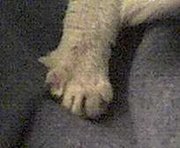
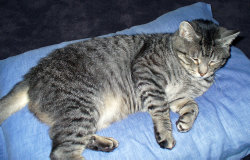 Male polydactyl cat with 6-7 digits/claws on the front paws, and 5 on the hind
paws.
Male polydactyl cat with 6-7 digits/claws on the front paws, and 5 on the hind
paws.
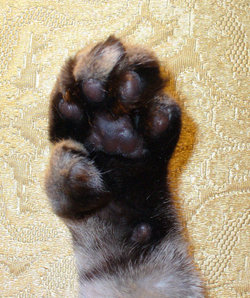 Opposable 'thumb' on male polydactyl cat. There used to be a digitless claw
protruding from the crevice between the 'thumb' and 'index finger'.
Opposable 'thumb' on male polydactyl cat. There used to be a digitless claw
protruding from the crevice between the 'thumb' and 'index finger'.
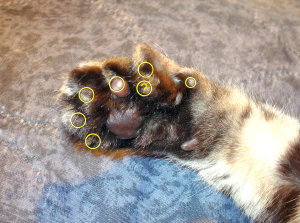 Right front paw of male polydactyle cat. Circles indicate digits. The circle
with a question mark is for what may be a separate digit. The rightmost circle
is for a small clawless digit.
Right front paw of male polydactyle cat. Circles indicate digits. The circle
with a question mark is for what may be a separate digit. The rightmost circle
is for a small clawless digit.
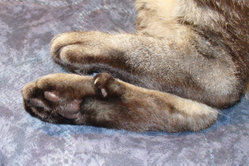 Hind dewclaw
on male polydactyl cat
Hind dewclaw
on male polydactyl cat
A polydactyl cat is one which has an abnormal number of digits on its paws. In animals including humans, polydactyly (or polydactylism, also known as hyperdactyly) is the anatomical abnormality of having more than the usual number of digits on the hands or feet. Polydactyly is a congenital abnormality, usually genetically inherited as an autosomal dominant trait. It seems to be most commonly found in cats along the eastern coast of the United States and in South West England.
Normal cats have five toes on each front paw and four toes on each hind paw. Polydactyl cats may have as many as seven digits on front and/or hind paws, and various combinations of anywhere from four to seven are common, although each of the front and rear paws are typically the same. A common variation is six toes on the front paws, with two opposing digits on each, (comparable in use to human thumbs). This feature enables the cat to learn and perform feats of manual dexterity generally not observed in non-polydactyl cats, such as opening latches on some cabinets, doors and windows.
Some polydactyl kittens initially have more difficulty in learning to walk and climb than normal animals. However, their extra abilities, once developed, endear them to many owners.
Sailors were long-known to especially value polydactyl cats for their extraordinary climbing and hunting abilities as an aid in controlling shipboard rodents. Some sailors also considered them to be extremely good luck when at sea. Nobel Prize-winning author Ernest Hemingway was one of the more famous lovers of polydactyl cats, after being first given a six-toed cat by a ship's captain. Upon Hemingway's death in 1961, his will provided that his former home in Key West, Florida should become a museum and a home for his cats, and it currently houses approximately sixty descendants of his cats (about half of which are polydactyl).
Sources and external links
- Hemingway Home Museum, Key West Florida, cats webpage
- American Polydactyl Cats
- Article on polydactylism in cats in New England
- Polydactyl Cats Photo Gallery online
- Images of polydactyl cats
